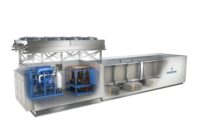Lighting presents a unique challenge in cold storage applications. While it’s not typically considered a primary factor in operations—more like an inconspicuous necessity, that is, until something goes wrong—the right lighting can actually play a substantial role in facility safety, productivity and cost-efficiency.
Fluorescent fixtures have been a staple in refrigeration environments for years, favored for their relatively low cost of acquisition. However, as many facility managers can attest, this is essentially where the benefit ends. Despite their initial low cost, fluorescents are an ongoing maintenance nightmare, with bulbs and ballasts that are delicate and prone to failure. Part of the problem is the nature of fluorescent fixture design, but cold temperatures exacerbate the issue, causing premature failure, which turns these “inexpensive” fixtures into some of the costliest to maintain.
As companies look to optimize overall energy and cost efficiency, productivity and performance, industrial LED fixtures are becoming a more effective, sustainable and safer alternative.
If your facility is still struggling with fail-prone fluorescents, here are five reasons to consider making the switch to LED.
- Superior cold performance. Fluorescents require an extensive warm-up period in cold temperatures, and the colder the temperature, the longer it takes for them to reach full lumen output. Even once they’re on, they struggle to stay lit at temperatures -40°F, which causes the ballast to work harder and the lamp ends to turn black. This reduces light output and the lifetime performance of the lamps and ballast, causing reduced visibility and premature failure. The extended warm-up also essentially eliminates the ability to add occupancy sensors and other controls that make lighting more efficient. On the other hand, industrial LED fixtures actually perform better in cold zones than in moderate temperatures. With fixtures that can perform well in temperatures ranging from -40°F to 149°F, LEDs are well suited for refrigeration and freezer use. The cold temperatures help to mitigate the heat output from the electronics components, which makes the entire system work more efficiently and prolongs the life of the components. And, because LEDs are instant-on, there’s no warm-up period, which makes them perfectly suited for controls.
- Lower heat output. Typical fluorescents used in cold storage applications are high-output systems, primarily to offset the ambient cold and maintain better operating conditions for the fixture. But, these high-output systems produce excessive heat, which can make the refrigeration system work even harder to keep inventory at a suitable temperature, which lowers overall energy efficiency for the facility. LED fixtures, on the other hand, produce much less heat, which has a lower net impact on refrigeration and cooling systems. This keeps energy consumption and costs lower and ensures more stable temperature maintenance inside storage facilities.
- Reduced maintenance time and cost. Typical T-5 high-output lamps are lucky to last 20,000 hours in a cold storage facility. Because of their frequent failure rate, fluorescents require near constant maintenance to change out spent bulbs and burned-out ballasts. Not only does this ongoing maintenance consume an exorbitant amount of resources in terms of both time and money, it also can be a hindrance to productivity when crews must block cold storage warehouse pathways to change out bulbs and fixtures. LED fixtures have proven to dramatically reduce the need for lighting maintenance, virtually eliminating it in many cases. Many LED fixtures are rated to last 100,000 hours, providing at least a decade of maintenance-free performance. This saves companies tens or even hundreds of thousands of dollars a year, and frees up maintenance crews to perform more mission-critical work besides changing lightbulbs.
- Improved visibility. Even with high-output fixtures in place, fluorescents still fail to deliver the appropriate level of illumination, especially in high ceiling-mount situations that are common in cold storage warehouses. With only about 112 lumens per watt output and no directional light capability, fluorescents are an inadequate source for 50- to 100-foot ceiling heights, and this reduced visibility can directly affect worker safety and inventory fulfillment and turnover. Insufficient lighting is the leading cause of trip, slip and fall accidents, according to the U.S. Department of Labor, Washington, D.C., and inability to see product labels clearly can impact productivity and an increased error rate. With LED fixtures, the clear, crisp white light emitted creates a more vibrant, safer environment where employees can spot potential hazards quicker and are more alert to their surroundings.
- More sustainable operations. Sustainability is at the top of every company’s operational—and marketing—objectives. Not only is running leaner and greener better for the environment, but consumers are also more likely to purchase products from companies they perceive to be earth-conscious and environmentally friendly. Fluorescents consume more energy than LEDs, which contributes directly to increased pollution and environmental impact. Not to mention, each tube also contains mercury, phosphorous and other rare earth minerals that are both airborne and soil pollutants. Considering how often fluorescent tubes are changed out and disposed of, this impact can add up quickly, as well as pose a poisoning hazard to workers in the event of broken bulbs. Switching to high-efficiency LEDs not only reduces energy-production related pollution, but also eliminates the hazardous material risk because LEDs contain no harmful chemicals.
While fluorescent fixtures may seem cheaper to install, the long-term total cost of ownership for these inefficient systems is extremely high. By investing in high-efficiency, high-performance industrial LED fixtures, cold storage facilities can substantially lower their cost of lighting energy and maintenance while also improving overall facility efficiency, productivity and sustainable operations.



